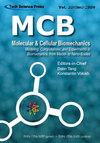The Influence of Enhanced External Counterpulsation Intervention on the Biomechanical Stress Distribution of Advanced Plaque: A 3D FSI Study Based on in vivo Animal Experiment
Q4 Biochemistry, Genetics and Molecular Biology
引用次数: 1
Abstract
Enhanced external counterpulsation (EECP) is an effective therapy to provide beneficial assistance for the failing heart by reducing cardiac afterload and increasing blood flow perfusion noninvasively. The technique of EECP involves the use of the EECP device to inflate and deflate a series of compression cuffs wrapped around the patient’s calves, lower thighs, and upper thighs. As the result, the enhanced flow perfusion is derived from the device’s propelling blood from veins of lower body to arteries of upper body and increases the blood supply for the important organs and brain. In the ACCF/AHA Guideline and ESC Guideline on the management of stable ischemic heart disease and coronary artery disease, EECP has been given a Class IIb and Class IIa recommendation respectively. In the ASA Guideline on the early management of Acute Ischemic stroke, EECP has been given a Class IIa recommendation. However, considering that EECP performance significantly elevates the acute blood pressure level as well as the perfusion level in systemic arterial tree and in diastolic, whether it will increase the risk of hypertension-related events such as atherosclerotic plaque rupture causes great concern in its clinical applications. But, the influence of EECP intervention on plaque progression remains elusive to this day and need to be assessed. It is generally agreed that biomechanical stresses play important roles in advanced atherosclerotic plaque progression and rupture. We hypothesized that EECP may intervene the advanced plaque progression via induced the variation of mechanical stresses in plaques. In this present paper, a pilot study containing animal experiment and numerical simulation was conducted to quantify the variations of biomechanical stresses of the plaque during EECP intervention. An experimentally induced hypercholesterolemic porcine model was developed and the basic hemodynamic measurements were performed in vivo before and during EECP intervention. Meanwhile, 3D multi-component idealized models with fluid-structure interactions (FSI) for carotid atherosclerotic plaques were introduced to solve the wall shear stress (WSS) and plaque structural stress (PWS) before and during intervention. Three cases of fibrous cap thickness (FC=600, 200 and 65μm) and three cases of material properties of the plaque components (normal, hard and soft) were involved in the current study. Numerical results showed that the max WSS level at the throat of the plaque, the 3D critical plaque wall stress (3D CPWS) level at the fibrous cap and the global max plaque wall stress (GMPWS) level at the shoulder of the plaque were all significantly augmented during EECP. When FC=65μm, EECP intervention augmented 118.1%±1.1% of the Max WSS level, 15.56%±1.68% of the 3D CPWS level and 14.78%±0.24% of the GMPWS level comparing to situations without EECP intervention. Considering that blood flow shear stress and structural stress are indexes that are presently thought might contribute to advanced plaque progression and its final rupture, our pilot study thus suggests that EECP treatment may intervene the plaque progression by elevating the levels of these indexes. But whether EECP treatment will increase the risk of plaque rupture and should be taken into account in its patient selection need a further detailed study and follow-up observation.增强体外反搏干预对晚期斑块生物力学应力分布的影响:基于动物体内实验的3D FSI研究
增强体外反搏(EECP)是一种有效的治疗方法,通过减少心脏后负荷和无创增加血流灌注,为心力衰竭提供有益的帮助。EECP技术包括使用EECP装置对患者小腿、大腿下部和大腿上部包裹的一系列压缩袖带进行充气和放气。因此,增强的血流灌注来自于该装置将血液从下体静脉推进到上体动脉,增加了重要器官和大脑的血液供应。在ACCF/AHA指南和ESC指南关于稳定型缺血性心脏病和冠状动脉疾病的治疗中,EECP分别被推荐为IIb和IIa级。在ASA急性缺血性卒中早期治疗指南中,EECP已被列为IIa级推荐。然而,考虑到EECP性能显著提高急性血压水平以及全身动脉树和舒张期灌注水平,是否会增加动脉粥样硬化斑块破裂等高血压相关事件的风险,在其临床应用中备受关注。但是,EECP干预对斑块进展的影响至今仍难以捉摸,需要进行评估。人们普遍认为生物力学应力在晚期动脉粥样硬化斑块进展和破裂中起重要作用。我们假设EECP可能通过诱导斑块中机械应力的变化来干预斑块的进展。在本文中,我们进行了一项包含动物实验和数值模拟的初步研究,以量化在EECP干预期间斑块生物力学应力的变化。建立了实验性高胆固醇血症猪模型,并在EECP干预前和干预期间进行了体内基本血流动力学测量。同时,引入具有流固相互作用(FSI)的颈动脉粥样硬化斑块三维多组分理想模型,求解干预前和干预过程中的壁面剪切应力(WSS)和斑块结构应力(PWS)。本研究涉及3例纤维帽厚度(FC=600、200和65μm)和3例斑块成分的材料特性(正常、硬、软)。数值结果表明,在EECP过程中,斑块喉部的最大WSS水平、纤维帽处的三维临界斑块壁应力(3D CPWS)水平和斑块肩部的全局最大斑块壁应力(GMPWS)水平均显著增加。当FC=65μm时,与未干预时相比,EECP干预使最大WSS水平提高118.1%±1.1%,3D CPWS水平提高15.56%±1.68%,GMPWS水平提高14.78%±0.24%。考虑到血流剪切应力和结构应力是目前被认为可能导致斑块进展和最终破裂的指标,我们的初步研究因此表明,EECP治疗可能通过提高这些指标的水平来干预斑块进展。但EECP治疗是否会增加斑块破裂的风险,在选择患者时是否需要考虑到这一点,还需要进一步的详细研究和随访观察。
本文章由计算机程序翻译,如有差异,请以英文原文为准。
求助全文
约1分钟内获得全文
求助全文
来源期刊

Molecular & Cellular Biomechanics
CELL BIOLOGYENGINEERING, BIOMEDICAL&-ENGINEERING, BIOMEDICAL
CiteScore
1.70
自引率
0.00%
发文量
21
期刊介绍:
The field of biomechanics concerns with motion, deformation, and forces in biological systems. With the explosive progress in molecular biology, genomic engineering, bioimaging, and nanotechnology, there will be an ever-increasing generation of knowledge and information concerning the mechanobiology of genes, proteins, cells, tissues, and organs. Such information will bring new diagnostic tools, new therapeutic approaches, and new knowledge on ourselves and our interactions with our environment. It becomes apparent that biomechanics focusing on molecules, cells as well as tissues and organs is an important aspect of modern biomedical sciences. The aims of this journal are to facilitate the studies of the mechanics of biomolecules (including proteins, genes, cytoskeletons, etc.), cells (and their interactions with extracellular matrix), tissues and organs, the development of relevant advanced mathematical methods, and the discovery of biological secrets. As science concerns only with relative truth, we seek ideas that are state-of-the-art, which may be controversial, but stimulate and promote new ideas, new techniques, and new applications.
 求助内容:
求助内容: 应助结果提醒方式:
应助结果提醒方式:


